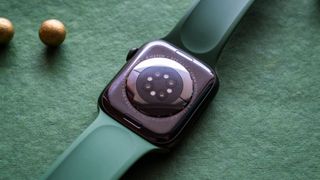Does your comfortable fluoroelastomer smartwatch band contain toxic chemicals that could transfer through your skin and cause eventual health issues? A scientific study suggests yes, but smartwatch brands like Apple and Google reassured me otherwise — at least about their straps.
Late last year, the nonprofit American Chemical Society posted a damning and concerning report“Presence of Perfluorohexanoic Acid in Fluoroelastomer Watch Bands,” by Wicks et al., suggesting that most common watch bands from the last few years have high levels of PFAS and PFHxA compounds with potential adverse health effects to the liver, thyroid, and other organs, as well as cancer.

The news made the rounds on consumer tech sites, and most readers had reason to worry: fluoroelastomer is one of the most common band materials for mainstream watches, along with silicone.
However, the study didn’t say which smartwatch straps they tested had toxic chemicals, except that they purchased 22 bands “across numerous brands and price points” from Amazon and Best Buy in 2023 and that 13 of the 22 tested bands were advertised to contain fluoroelastomer.
I got my hands on the full paywalled report, which shows how they used particle-induced gamma-ray emission and liquid chromatography-tandem mass spectrometry to determine which bands contained fluoride, PFAS, or PFHxA chemicals. The first is an expected ingredient in fluoroelastomer bands; the latter two are likely dangerous if ingested.
Of the 13 bands advertised as fluoroelastomer, seven had significant PFAS/ PFHxA chemical concentrations, while six had none or safely negligible concentrations. Of the other nine — likely using silicone or other common strap materials — only one had high PFAS/ PFHxA concentrations, and its high fluoride percentage suggests it might be a fluoroelastomer band in disguise.
What does this tell us? Fluoroelastomer bands aren’t inherently dangerous because some brands remove or avoid using harmful chemicals in their manufacturing. The problem is that a majority of brands don’t bother to do so, either out of negligence or ignorance of the implications. And we don’t know which brands these are.
Will your fluoroelastomer band actually make you sick?
(Image credit: Google)
Ingesting or inhaling PFAS compounds is dangerous, but most people aren’t going to eat their smartwatch straps. The question is whether or not “dermal absorption” of these chemicals is likely over years of wearing your smartwatch.
The team behind this ACS report can only answer this question vaguely because “dermal absorption of PFAS is poorly described” in a few scant studies. But because people wear smartwatches for 12+ hours per day, it “poses an opportunity for significant transfer to the dermis and subsequent human exposure.”
They specifically suggest that the “additional sweat contact and open skin pores” caused by wearing fitness smartwatches for workouts could pose an additional risk — though thankfully, many fitness watches default to sweat-wicking silicone or nylon bands.

(Image credit: Nicholas Sutrich / Android Central)
The study cites tests on mice that indicate PFAS and PFHxA will eventually absorb into your organs and bloodstream if placed on the skin. An “in vitro human skin equivalent model” absorbed “more than 50% of a PFHxA exposure dose.”
Despite all this fearful language, it remains educated conjecture, not a certainty. It’s unclear how much PFAS and PFHxA will actually transfer into your body over time and whether it would ever reach high enough levels to pose a health risk.
The study itself concludes that the findings “highlight a critical need for a more comprehensive exposure study of PFHxA that arises from fluoroelastomer watch bands worn on human skin.” They never conclude a direct correlation between wearing a fluoroelastomer band and getting sick.
Some fluoroelastomer bands have toxic chemicals, but we don’t know whether they actually transfer through your skin, or if it’s enough to cause long-term harm.
A relevant parallel to this fear-inducing study is the recent panic over black plastic cooking utensils and pans with high levels of flame retardants (via the New York Times), with evidence suggesting that these chemicals could leach into your food over time, especially in the presence of high cooking temperatures and oils.
That report probably led to some mass-dumping of black plastic spatulas, but it arose later in 2024 that the scientists had made a math error that magnified the issue by 10X, making it look worse than it was. And truly, the only way that the retardants will transfer to your food in significant quantities is if you leave your spatula sitting in hot oil for minutes at a time, which most people naturally wouldn’t do.
My point is you can certainly replace your fluoroelastomer band; there are so many watch band alternatives like silicone, nylon, metal, and leather, if you’re concerned. However, until there’s concrete evidence of the rate or impact of dermal PFAS/PFHxA absorption in humans, you shouldn’t panic about the years you’ve spent wearing a fluoroelastomer strap.
Plus, your fluoroelastomer band may not have any PFAS or PFHxA chemicals to begin with!
Brands like Apple and Google say their bands are safe

(Image credit: Apoorva Bhardwaj / Android Central)
I emailed my contacts at Apple, Google, and Samsung about this report, asking if they have any comment on the findings, if their customers have reason to switch bands, and if they’ll change any manufacturing processes in the future.
Samsung has yet to get back to me, but Apple and Google readily shared white papers indicating that they’re already aware of the potential dangers and proactively remove PFAS from their smartwatch bands.
“Pixel Watch bands meet industry standards with regard to PFAS,” Google told Android Central. “We proactively limit PFAS in our products and are committed to minimizing PFAS beyond what is required by law.” Its white paper references PFAS, saying it would avoid “detectable levels” or up to 25 ppb of the compound in any device.
Apple’s statement echoes Google’s, and the company shared its 2022 white paper outlining its PFAS policy.
“Over a decade ago, we successfully eliminated two PFAS members — PFAS and PFOA — from our products,” Apple told Android Central. “Apple has been working to phase out PFAS from all our products and manufacturing processes, which includes engaging with all of our supply chain partners and developing safer alternatives.”

(Image credit: Michael Hicks / Android Central)
I’ll update this post if Samsung responds, but I did find the Samsung Electronics Standards for Control of Substances used in products, which lists PFAS in its “Potentially Risk Substances” and PFHxA in its “Restricted Substances” list with a 25㎍/kg maximum; however, it lists July 2026–2027 as the implement date, so it’s possible that it has been (or is currently) used in “skin contact textiles.”
At the very least, it’s comforting that the biggest smartwatch brands have recognized the dangers of toxic compounds in smartwatch straps and taken steps to remove them. It’s possible that two of the PFAS-free fluoroelastomer bands in the 2023 study came from the Apple Watch S9 and Pixel Watch 2.
If your Android watch comes from another brand, I still urge you not to worry prematurely. But most brands offer an easy way to swap out straps if you don’t want to stress about it, and we do have guides on alternative bands — like Galaxy Watch 7 bands — if you want to shop around.




GIPHY App Key not set. Please check settings